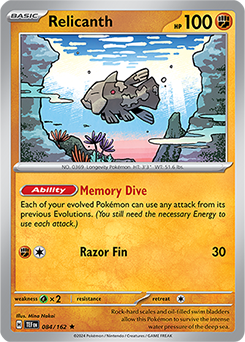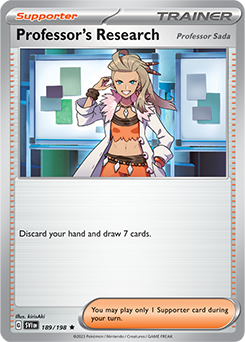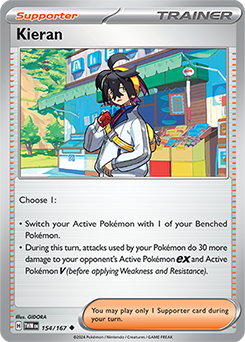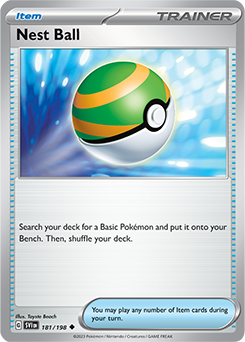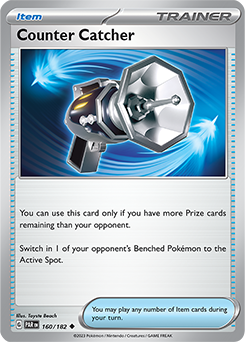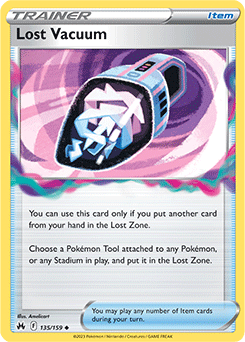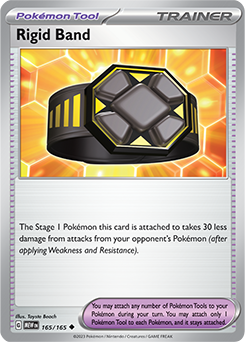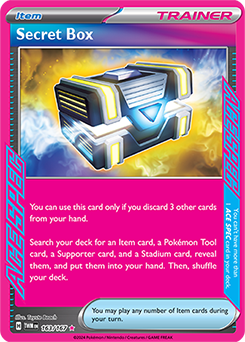By Stéphane Ivanoff, Contributing Writer
Two years ago, when I was preparing for the 2022 World Championships in London, I was obsessed with Origin Forme Dialga VSTAR. The Pokémon TCG: Pokémon GO expansion had just released, and I was determined to prove that PokéStop was an incredible card—something that many players doubted at the time—and it made sense to play it with Dialga VSTAR, which played Metal Saucer and other strong Item cards. The deck could do incredibly powerful things when things went its way, but it also seemed to be missing a bit of consistency to make it great, so playing it was a risky prospect, to say the least. I debated for a long time whether I should stick with a safer deck choice, but in the end, I wanted to try it. So, I took a gamble and brought Dialga VSTAR to the World Championships.
This gamble did not pay off.
After that, I never played Dialga VSTAR again. In the following season, though, I made Top 8 at three major events in Europe, one with Duraludon VMAX and two with Hisuian Goodra VSTAR. My friend Antoine joked that I was trying to cope with my breakup with Dialga by cozying up to other Steel- and Dragon-type Pokémon. So when the editorial manager here at Pokemon.com offered me to write about Archaludon ex, the newest Steel- and Dragon-type Pokémon to be featured on a card, it felt only natural for me to accept.
Both Duraludon VMAX and Hisuian Goodra VSTAR were tanky Pokémon and, unlike Dialga VSTAR, featured in defensive decks. Archaludon ex follows in their footsteps: 300 HP is a lot for a Stage 1 Pokémon, and Metal Defender removes its Weakness for a turn, so even a Fire-type attacker like Radiant Charizard won’t take it down. What’s more, its Assemble Alloy Ability allows Archaludon ex to attach Metal Energy from the discard pile to itself or other Metal-type Pokémon when it evolves. This makes Professor Turo’s Scenario a great card in an Archaludon ex deck. You can pick up a damaged Archaludon ex, discarding its Energy, then promote a Duraludon, evolve it into the Archaludon ex you just got back in your hand, and attach two Energy back to it. As long as you have another Metal Energy (or Night Stretcher), you can attack with Metal Defender again, all damage healed. Duraludon, Archaludon ex’s pre-Evolution, has a massive 130 HP, so it’s not at risk of being KO’d by residual damage—from Dragapult ex’s Phantom Dive, for example—like some other popular evolving Basic Pokémon, such as Pidgey and Duskull.
Duraludon also has the Raging Hammer attack, which does damage based on the amount of damage counters on it. This attack is unremarkable on Duraludon, but thanks to Relicanth’s Memory Dive Ability, Archaludon ex can use this attack as well! This way, if a Pokémon does high damage to it without knocking it out, Archaludon ex can retaliate by taking the KO itself. For example, if Lugia VSTAR hits Archaludon ex for 220 damage with Tempest Dive, or even for 200 if it has a Double Turbo Energy attached, Lugia VSTAR will get hit back by a 300—or 280—damage attack, which will knock it out. It’s often better to opt to heal Archaludon ex with Professor Turo’s Scenario, but having the option of going on the offensive can get the deck out of some difficult situations.
Now that the basics of the deck are out of the way, I’d like to showcase this deck list. To give credit where credit’s due, many of the ideas in it come from my friend Cédric Paporello, who’s been an Archaludon ex enthusiast ever since he saw the card.
The Best Offense Is a Great Defense: Archaludon ex Basics
As I mentioned, this deck is fairly defensive in nature, and that’s reflected in the use of cards like Rigid Band. When I play this deck, I want my opponent to be forced to hit my Archaludon ex, allowing me to heal it up and, essentially, cancel my opponent’s last turn. Therefore, I don’t want to have Pokémon that are easy to KO on my Bench, which would be juicy targets that my opponent could use to avoid having to deal with Archaludon ex.
Single-Prize Pokémon are acceptable, and Radiant Greninja makes a great addition to the deck, being able to discard Energy to draw cards, knowing that these Energy can then be attached back in play by Archaludon ex’s Assemble Alloy Ability. However, multi-Prize support Pokémon are to be avoided. I’ve included Lumineon V, as it is invaluable in games where we struggle to set up, but it is a concession and not an enthusiastic addition to the deck. I don’t want to add Fezandipiti ex or Rotom V.
However, as I mentioned, I want to be able to use Professor Turo’s Scenario regularly, and in order to do that, the deck needs some form of draw power. This is where my old obsession PokéStop comes into play! By now, the card’s power has been thoroughly demonstrated, so I’m not adding it to the deck due to personal feelings but because it fits. It’s a Stadium that can draw cards, so it can help to find cards like Ultra Ball and Earthen Vessel to get the deck started. It can also discard Energy, which is good since the deck needs a couple Energy in the discard pile within the first few turns so Archaludon ex can attack faster. However, PokéStop will also send Pokémon and Supporter cards to the discard. The rest of the deck is made to mitigate this issue.
Keep the Tin out of the Bin: Recovering Key Pieces
Thanks to a 2-2 Banette line, this deck can recover Supporter cards from the discard pile using the Puppet Offering Ability. This makes it easier to use Professor Turo’s Scenario several times over the course of the game. In fact, sometimes it’s good to discard Professor Turo’s Scenario with PokéStop, because Banette will be able to grab it. Banette also sends itself to the Lost Zone after using its Ability. In the late game, this means that it can be removed from play easily, which plays into the strategy of not letting the opponent have easy Prize cards to take. It’s possible to end up with a board where you have only one Archaludon ex in play, so even if the opponent has a single Prize card remaining, they have no option other than to deal with the 300-HP behemoth.
Then we have Night Stretcher, which recovers Pokémon or Energy from the discard pile. It lets you get Pokémon like Shuppet and Banette if they get discarded, or it could also give you Energy to last the whole game. In a pinch, you can use it to grab a Metal Energy to use Radiant Greninja’s Concealed Cards. The synergy between Night Stretcher and PokéStop is excellent and has been used in several decks this season, like Palkia VSTAR / Dusknoir and Lost Zone Box.
In addition to these cards, I also included a copy of Pal Pad and Super Rod. These are used more toward the late game to recover resources that have been used or discarded throughout the game. Night Stretcher, Pal Pad, and Super Rod are all Item cards, so they will never get lost when activating PokéStop. This means that you can feel safe using PokéStop in the early game, because the deck has safeguards in place. The only cards that can’t be recovered if they’re discarded are extra PokéStops and Tool cards, which are acceptable losses most of the time.
But one mustn’t look only at the risks of PokéStop—the rewards are higher! In addition to some Item cards I’ve already mentioned, PokéStop can also let you draw Pokégear 3.0, which can used to find a Supporter card, or even the ACE SPEC Secret Box, which gives you access to basically everything you want. Secret Box is one more way for the deck to find Professor Turo’s Scenario, but it will grab other cards. It also lets you find any of the deck’s situational (tech) cards. There are four of them, and I will now explain them.
Pushing the Pedal to the Metal: Tech Cards
Vitality Band is a Pokémon Tool card that increases damage by 10. That’s not much, but it means that Archaludon ex hits for 230 instead of 220 damage, which is very relevant in the Standard format. It gives it a one-hit Knock Out against powerful Basic Pokémon such as Terapagos ex, Roaring Moon ex, and Iron Hands ex.
Kieran is also used mainly as a damage boost, letting Metal Defender hit for 250 damage. That can take out a few more opponents, like Raging Bolt ex and Banette ex. Kieran is a Supporter card, so you can’t use it in combination with Boss’s Orders or Professor Turo’s Scenario, but on the bright side, you can get it back with Banette.
Lost Vacuum is a fairly versatile card that is often used to remove Bravery Charm from big Basic Pokémon in order to ensure you knock them out but can also get rid of any other relevant Pokémon Tool card or even a Stadium. Here’s one neat trick you can use to draw more Item cards: If PokéStop is in play at the start of your turn, you can activate it to get some Item cards, use Lost Vacuum to remove it from play, then play a new PokéStop from your hand and activate this one too!
Finally, Canceling Cologne is used in a variety of situations. It lets Archaludon ex Knock Out Pokémon whose Abilities would otherwise prevent it, such as Pikachu ex and Cornerstone Mask Ogerpon ex, and it can be used to remove Flutter Mane’s Midnight Fluttering Ability for a turn if you need to.
Test Your Metal: Archaludon ex Starting Tips
If you’ve followed all of this, you have almost everything you need to know to play Archaludon ex! To help you get started, though, I’ll add a couple of tips:
-
Discarding Metal Energy is ideal in the early game for your first Assemble Alloy, so make good use of those Ultra Ball and Earthen Vessel! Later in the game, though, there’s no need to discard even more Energy as you don’t get any extra benefit from it—this isn’t a Gardevoir ex deck!—and your Energy cards are precious, both to attach to your Pokémon and as Concealed Cards fodder. There are often better cards to discard: Nest Ball, when all your Basic Pokémon are out of the deck; PokéStop, if your opponent is also playing a PokéStop deck (so the Stadium will always stay in play); or Counter Catcher when you’re ahead in the Prize race...
-
Don’t be afraid to use PokéStop in the early game, as even if you discard some cards, almost all your resources are recoverable. In the late game, though, don’t activate it mindlessly. If there’s just one Boss’s Orders left in your deck and you know you can’t win without it, don’t take the risk of discarding it (unless you have no other choice in order not to lose and you’re banking on getting a Pokégear 3.0 from PokéStop).
-
Make sure you play your cards in the right order. Nest Ball and Earthen Vessel should be played before using PokéStop, as you’ll be more likely to draw into Item cards if you’ve removed some non-Item cards from your deck beforehand. On the other hand, Pal Pad and Super Rod, which put non-Item cards back in your deck, should be played after PokéStop. Pokégear 3.0 is an interesting case—you should usually play it before using PokéStop, as it falls in the same category as Nest Ball and Earthen Vessel. However, if you really need to find a key Supporter (say, Boss’s Orders) for the turn, and you have Banette, then it is better to use PokéStop first. This way, you can dig deeper into your deck with Pokégear 3.0. And if you happen to discard the Supporter you want by using PokéStop, then Banette can always get it back for you.
Now you should be truly ready, so don’t be afraid to build the deck and try it out! And don’t worry about strange scenarios that I haven’t discussed in this guide—you’ll cross that bridge when you get to it! (Get it? It’s funny because Archaludon is a bridge.)

Stéphane Ivanoff is a contributing writer for Pokemon.com. A longtime Pokémon fan, he has played the Pokémon TCG competitively since 2010 and is a former National Champion, seven-time Worlds competitor, and the 2018 and 2019 North America International Champion in the Masters Division. He studied mathematics and has a degree in Probability and Statistics, but he says that doesn't help his game as much as you'd think! You can follow him on X @lubyllule.








